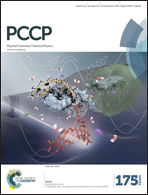Spatially resolved surface valence gradient and structural transformation of lithium transition metal oxides in lithium-ion batteries†
Abstract
Layered lithium transition metal oxides are one of the most important types of cathode materials in lithium-ion batteries (LIBs) that possess high capacity and relatively low cost. Nevertheless, these layered cathode materials suffer structural changes during electrochemical cycling that could adversely affect the battery performance. Clear explanations of the cathode degradation process and its initiation, however, are still under debate and not yet fully understood. We herein systematically investigate the chemical evolution and structural transformation of the LiNixMnyCo1−x−yO2 (NMC) cathode material in order to understand the battery performance deterioration driven by the cathode degradation upon cycling. Using high-resolution electron energy loss spectroscopy (HR-EELS) we clarify the role of transition metals in the charge compensation mechanism, particularly the controversial Ni2+ (active) and Co3+ (stable) ions, at different states-of-charge (SOC) under 4.6 V operation voltage. The cathode evolution is studied in detail from the first-charge to long-term cycling using complementary diagnostic tools. With the bulk sensitive 7Li nuclear magnetic resonance (NMR) measurements, we show that the local ordering of transition metal and Li layers (R![[3 with combining macron]](https://www.rsc.org/images/entities/char_0033_0304.gif) m structure) is well retained in the bulk material upon cycling. In complement to the bulk measurements, we locally probe the valence state distribution of cations and the surface structure of NMC particles using EELS and scanning transmission electron microscopy (STEM). The results reveal that the surface evolution of NMC is initiated in the first-charging step with a surface reduction layer formed at the particle surface. The NMC surface undergoes phase transformation from the layered structure to a poor electronic and ionic conducting transition-metal oxide rock-salt phase (R
m structure) is well retained in the bulk material upon cycling. In complement to the bulk measurements, we locally probe the valence state distribution of cations and the surface structure of NMC particles using EELS and scanning transmission electron microscopy (STEM). The results reveal that the surface evolution of NMC is initiated in the first-charging step with a surface reduction layer formed at the particle surface. The NMC surface undergoes phase transformation from the layered structure to a poor electronic and ionic conducting transition-metal oxide rock-salt phase (R![[3 with combining macron]](https://www.rsc.org/images/entities/char_0033_0304.gif) m → Fm
m → Fm![[3 with combining macron]](https://www.rsc.org/images/entities/char_0033_0304.gif) m), accompanied by irreversible lithium and oxygen loss. In addition to the electrochemical cycling effect, electrolyte exposure also shows non-negligible influence on cathode surface degradation. These chemical and structural changes of the NMC cathode could contribute to the first-cycle coulombic inefficiency, restrict the charge transfer characteristics and ultimately impact the cell capacity.
m), accompanied by irreversible lithium and oxygen loss. In addition to the electrochemical cycling effect, electrolyte exposure also shows non-negligible influence on cathode surface degradation. These chemical and structural changes of the NMC cathode could contribute to the first-cycle coulombic inefficiency, restrict the charge transfer characteristics and ultimately impact the cell capacity.


 Please wait while we load your content...
Please wait while we load your content...